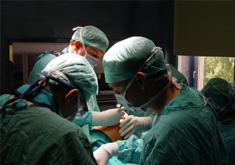Manejo no quirúrgico del trauma esplénico cerrado

1. N.A. Stassen, I. Bhullar, J.D. Cheng, et al. Selective nonoperative management of blunt splenic injury: an Eastern Association for the Surgery of Trauma practice management guideline. J Trauma Acute Care Surg, 73 (5 Suppl 4) (2012), pp. S294–S300
2. C.S. Cocanour, F.A. Moore, D.N. Ware, et al. Delayed complications of nonoperative management of blunt adult splenic trauma. Arch Surg, 133 (1998), pp. 619–624 discussion, 624–5
3. A.B. Peitzman, B. Heil, L. Rivera, et al. Blunt splenic injury in adults: Multi-institutional Study of the Eastern Association for the Surgery of Trauma. J Trauma, 49 (2000), pp. 177–187 discussion, 187–9
4. L. Moore, H.T. Stelfox, A.F. Turgeon, et al. Rates, patterns, and determinants of unplanned readmission after traumatic injury: a multicenter cohort study. Ann Surg, 259 (2014), pp. 374–380
5. N. Johnson, M. Cevasco, R. Askari. Delayed presentation of perisplenic abscess following arterial embolization. Int J Surg Case Rep, 4 (2013), pp. 108–111
6. M.R. Molin, S.R. Shackford. The management of splenic trauma in a trauma system. Arch Surg, 125 (1990), pp. 840–843
7. A.A. Clancy, C. Tiruta, D. Ashman, et al. The song remains the same although the instruments are changing: complications following selective non-operative management of blunt spleen trauma: a retrospective review of patients at a level I trauma centre from 1996 to 2007. J Trauma Manag Outcomes, 6 (2012), p. 4
8. B.L. Zarzaur, S. Vashi, L.J. Magnotti, et al. The real risk of splenectomy after discharge home following nonoperative management of blunt splenic injury. J Trauma, 66 (2009), pp. 1531–1536 discussion, 1536–8
9. Healthcare Cost and Utilization Project, Overview, 2015, Healthcare Cost and Utilization Project; Rockville, MD, [updated November 2014]; Available at: http://www.hcup-us.ahrq.gov/sidoverview.jsp. Accessed March 20, 2015.
10. Centers for Medicare and Medicaid Services. ICD-9-CM official guidelines for coding and reporting, US GPO, Washington, DC, 2011.
11. M.E. Charlson, P. Pompei, K.L. Ales, et al. A new method of classifying prognostic comorbidity in longitudinal studies: development and validation. J Chronic Dis, 40 (1987), pp. 373–383
12. Clark DE, Osler TM, Hahn DR. ICDPIC: Stata module to provide methods for translating International Classification of Diseases (Ninth Revision) diagnosis codes into standard injury categories and/or scores, 2009, Boston College; Chestnut Hill, MA, [updated October 2010]; Available at: https://ideas.repec.org/c/boc/bocode/s457028.html. Accessed January 3, 2015.
13. T. Osler, R. Rutledge, J. Deis, et al. ICISS: an international classification of disease-9 based injury severity score. J Trauma, 41 (1996), pp. 380–386 discussion, 386–8
14. E.E. Moore, T.H. Cogbill, G.J. Jurkovich, et al. Organ injury scaling: spleen and liver (1994 revision). J Trauma, 38 (1995), pp. 323–324
15. M.T. Kassin, R.M. Owen, S.D. Perez, et al. Risk factors for 30-day hospital readmission among general surgery patients. J Am Coll Surg, 215 (2012), pp. 322–330
16. A.M. Ingraham, K.E. Richards, B.L. Hall, et al. Quality improvement in surgery: the American College of Surgeons National Surgical Quality Improvement Program approach. Adv Surg, 44 (2010), pp. 251–267
17. Q. Gu, L. Koenig, J. Faerberg, et al. The Medicare hospital readmissions reduction program: potential unintended consequences for hospitals serving vulnerable populations. Health Serv Res, 49 (2014), pp. 818–837
18. A. Hagiwara, T. Yukioka, S. Ohta, et al. Nonsurgical management of patients with blunt splenic injury: efficacy of transcatheter arterial embolization. AJR Am J Roentgenol, 167 (1996), pp. 159–166
19. P.P. Liu, W.C. Lee, Y.F. Cheng, et al. Use of splenic artery embolization as an adjunct to nonsurgical management of blunt splenic injury. J Trauma, 56 (2004), pp. 768–772
20. T.C. Tsai, E.J. Orav, A.K. Jha. Care fragmentation in the postdischarge period. JAMA Surg, 150 (2015), pp. 59–64
21. T.L. Overton, S. Shafi, R.R. Gandhi. Local access to care programs increase trauma patient follow-up compliance. Am J Surg, 208 (2014), pp. 476–479
22. D.D. Yeh, A.M. Imam, S.H. Truong, et al. Incidental findings in trauma patients: dedicated communication with the primary care physician ensures adequate follow-up. World J Surg, 37 (2013), pp. 2081–2085
23. P. Fata, L. Robinson, S.M. Fakhry. A survey of EAST member practices in blunt splenic injury: a description of current trends and opportunities for improvement. J Trauma, 59 (2005), pp. 836–841 discussion, 841–2
Comentarios
Para ver los comentarios de sus colegas o para expresar su opinión debe ingresar con su cuenta de IntraMed.












